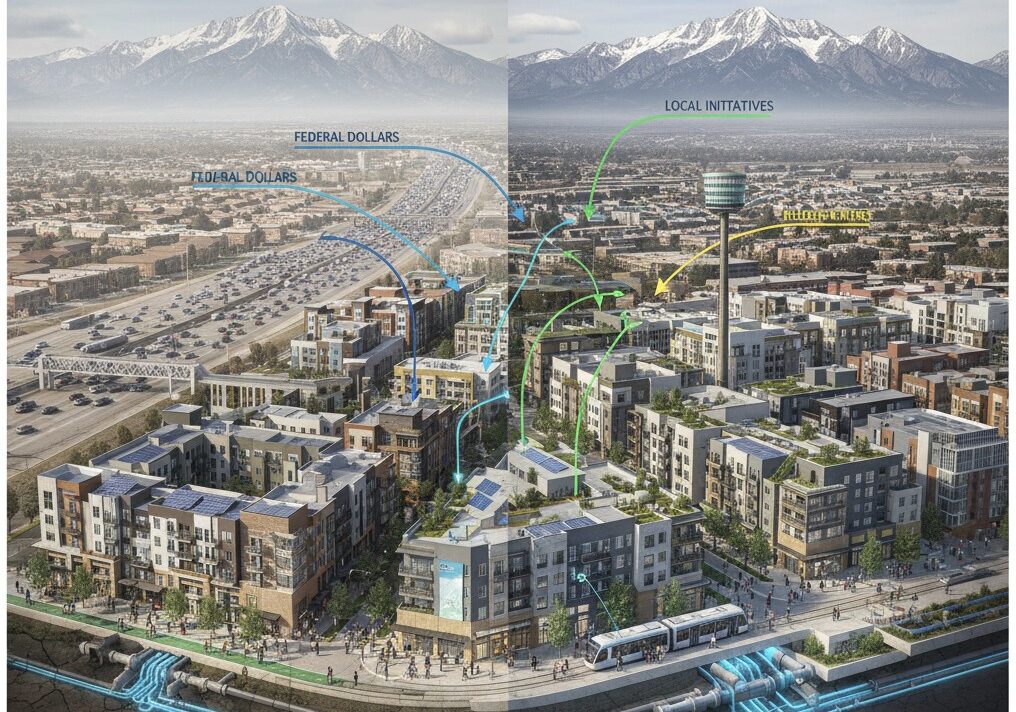Colorado’s stunning mountains, vibrant cities, and booming economy have made it one of the fastest-growing states in the nation. This real estate frenzy has created a critical tension: the boom is outpacing the state’s capacity to build and fund the essential infrastructure to sustain it, from roads and water systems to schools and high-speed internet.
Balancing this growth with infrastructure development is the central challenge for Colorado’s future. It demands a shift from reactive planning to proactive, innovative, and collaborative strategies.
The Price of Sprawl: The Infrastructure Deficit
For years, development often moved outward, seeking cheaper land far from city centers. This low-density sprawl carries a massive hidden cost:
- Transportation Gridlock: Every new development far from work centers means more cars on the road, increasing traffic, air pollution, and the eventual need for costly new highway lanes. According to recent reports, Colorado’s congestion continues to be a major economic and environmental burden.
- Strained Utilities: Extending water lines, sewer systems, and power grids over long distances for scattered developments is enormously expensive and inefficient. In a state prone to drought, this puts immense pressure on water resources—perhaps the most critical infrastructure challenge facing the state’s future growth.
- Fragmented Funding: Local jurisdictions have historically relied heavily on impact fees and incremental local taxes to fund infrastructure. While necessary, this piecemeal approach is often insufficient for large, regional projects that benefit multiple communities, resulting in a persistent funding gap. The American Society of Civil Engineers (ASCE) has pointed to a significant backlog of infrastructure maintenance and upgrades across the state.
The Policy Shift: Incentivizing Smart Density
Colorado’s recent legislative efforts signal a necessary, top-down shift to address this imbalance by rewarding density and strategic location near existing services. This is encapsulated in the concept of Transit-Oriented Communities (TOCs).
Transit-Oriented Development (TOD)
State legislation, such as the Transit-Oriented Communities bill, directly encourages local governments to increase housing density near existing or planned transit stops. This approach is powerful for two reasons:
- Maximized Efficiency: By concentrating housing (including affordable housing) and commercial activity near rail and bus lines, the state maximizes the utility of its existing transportation investment, reducing the need for new road capacity.
- Reduced Commute Times & Emissions: High-density, mixed-use neighborhoods allow residents to walk, bike, or take transit for daily needs, shrinking vehicle miles traveled (VMT), lowering personal transportation costs, and improving regional air quality.
To support this, the state has tied grant programs, like the Transit-Oriented Communities Infrastructure Grant Program, to compliance with these denser land use policies. This creates a financial incentive for cities and counties to rezone and plan smarter.
Diversified and Collaborative Funding
Building smarter also means funding smarter. Colorado is moving away from sole reliance on a few sources toward a blended model:
- Federal Dollars and Local Alignment: The state has been successful in drawing down historic federal infrastructure funds (IIJA and IRA), allocating billions toward broadband, water, and climate resilience projects. The key is ensuring these funds are paired with local planning that supports infill development and housing growth, preventing new infrastructure from enabling further unsustainable sprawl.
- Public-Private Partnerships (P3s): While not a silver bullet, P3s remain a critical tool for leveraging private capital and expertise to accelerate complex public works, especially in transportation, which can move projects forward faster than traditional public funding alone.
- Housing Policy Reform: New state laws have focused on simplifying the process for building Accessory Dwelling Units (ADUs) and reducing restrictive minimum parking requirements near transit. These subtle changes increase the total housing supply within established neighborhoods, utilizing existing water, sewer, and transportation lines without the massive cost of building entirely new systems.
Building a Resilient Future
Balancing Colorado’s real estate boom with its infrastructure needs requires a long-term vision that views housing, transportation, and utilities as an integrated system, not separate concerns.By pushing for strategic infill development, rewarding communities that embrace smart density, and ensuring development costs reflect their true impact on public services, Colorado can change the growth equation. We can ensure the state remains a place where people can afford to live, commute efficiently, and thrive, securing its economic and environmental resilience for generations to come.
#ColoradoRealEstate #COhousing 🛣️#SmartGrowth #Infrastructure #FutureofCities🏷️#RealEstateDevelopment #UrbanPlanning #SustainableDevelopment





